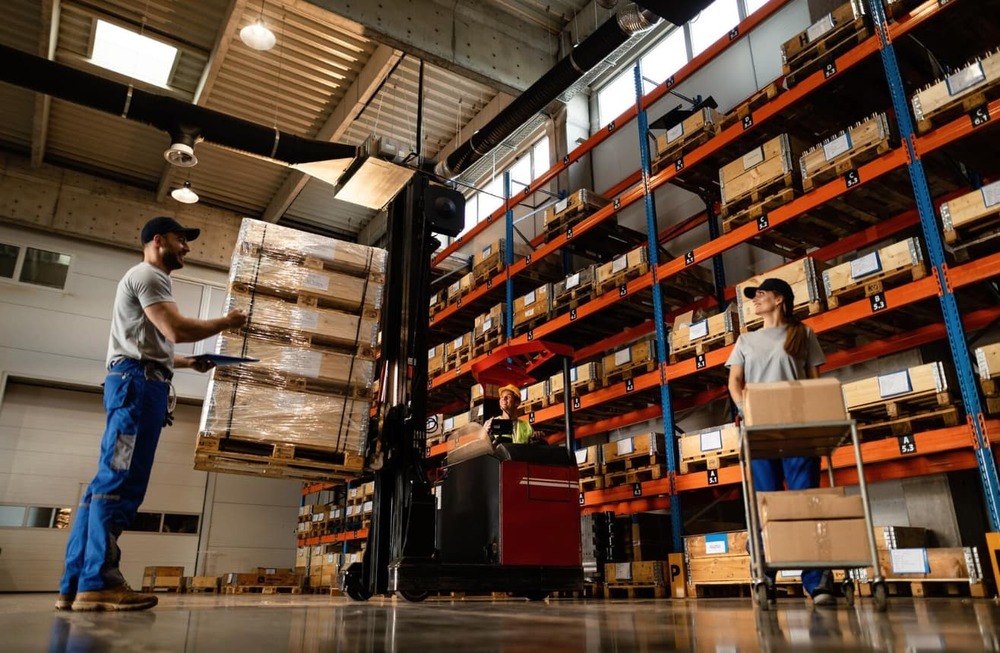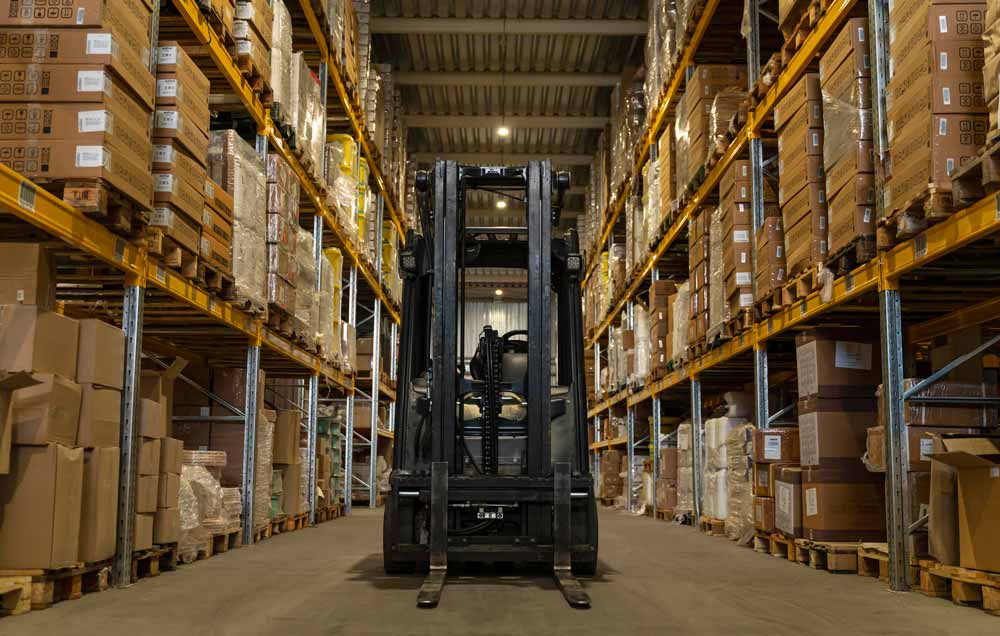Warehousing today goes beyond storage—it’s about optimizing inventory flow with precision and speed. As supply chains grow more complex and customer expectations rise, warehouse management systems (WMS) have become essential.
To meet unprecedented demands for accuracy and efficiency, businesses are adopting WMS solutions that deliver real-time inventory tracking, streamline operations, and enhance logistics performance. Target, for example, uses an AI-powered Inventory Ledger to monitor over 40% of its product assortment, generating billions of weekly predictions to forecast demand and manage stock.
Here are some of the best benefits of WMS you can’t miss for your business.
Table of Contents
Key Takeaways
✔ WMS maximizes warehouse capacity by using smart slotting, zoning, and vertical space to optimize storage space.
✔ WMS improves inventory accuracy through real-time tracking and automation that reduce stock errors and mismatches.
✔ By optimizing picking routes and automating tasks, WMS accelerates order fulfillment and reduces processing time.
✔ WMS lowers operational costs by cutting labor, equipment, and storage expenses while eliminating manual inefficiencies.
✔ WMS enhances forecasting accuracy by using historical and real-time data to support better demand planning.
✔ WMS boosts customer satisfaction by ensuring accurate, on-time orders with transparent tracking and smooth returns.
✔ WMS increases workforce efficiency through task automation, guided workflows, and real-time performance tracking.
✔ WMS unifies supply chain systems by integrating seamlessly with ERP, TMS, and e-commerce platforms for end-to-end coordination.
1. Maximize Space Utilization
A WMS plays a crucial role in turning every inch of a warehouse into productive space. The importance of warehouse management system in spatial efficiency cannot be overstated—it ensures facilities can handle growing inventory without the need for expansion.
Facilities that invest in both warehouse automation and WMS technologies not only gain additional space, but they also gain operational clarity, faster material flow, and higher capacity without additional square footage.
Key contributions of WMS to space utilization include:
- Smart Slotting Algorithms: The system identifies high-frequency SKUs and assigns them to easily accessible zones, improving throughput and minimizing congestion.
- Dynamic Reallocation: As demand shifts, WMS can reassign product locations to accommodate seasonal surges or new inventory types. This dynamic flexibility improves layout without disrupting operations.
- Zoning for Efficiency: WMS defines specialized zones (e.g., bulk, picking, returns) based on SKU velocity and handling needs, leading to better storage discipline.
- Integration with Warehouse Automation: Mechanized systems such as vertical carousels and AS/RS (automated storage and retrieval systems) maximize cube utilization, making use of vertical height that manual systems ignore.
- Reduction in Overstocking Footprint: By supporting inventory accuracy improvement, WMS helps businesses avoid over-ordering, freeing up space that would otherwise be wasted on excess stock.
Faster Storage-to-Shipping Transition: Optimized layouts reduce movement time, contributing directly to logistics efficiency and overall productivity.
![]()
2. Enhance Inventory Accuracy
Precise inventory data is critical to ensuring smooth warehousing and fulfillment processes. Inaccurate stock levels can derail supply chains, trigger customer complaints, and damage financial performance. This is where the importance of warehouse management systems shines—by ensuring inventory accuracy improvement through consistent, automated monitoring.
In warehouses with high SKU complexity or rapid turnover, real-time inventory management enabled by a WMS eliminates guesswork and provides a single source of truth. The end result? Fewer fulfillment errors, more reliable forecasting, and better control over working capital.
WMS ensures inventory precision through the following:
- Real-Time Inventory Management: Every stock movement—whether it’s a pallet received or an item picked—is tracked instantly. This eliminates time lags between physical movement and system updates.
- Barcode and RFID Integration: Using scanners or RFID readers, the system logs each product’s exact location and movement. This minimizes human error and allows for traceability across multiple touchpoints.
- Automated Reconciliation: WMS runs regular cycle counts and alerts users to discrepancies between expected and actual stock, reducing reliance on manual, error-prone audits.
- Misplacement Prevention: WMS alerts operators when items are stored in the wrong location or when similar-looking items are at risk of being confused. This contributes to overall inventory accuracy improvement.
- Safety Stock Visibility: Businesses can set thresholds and receive automatic notifications before stockouts occur, maintaining fulfillment continuity and logistics efficiency.
- Data-Driven Auditing: WMS generates reports that allow supply chain teams to review variances, loss patterns, and inventory performance over time.
3. Improve Order Fulfillment Speed
Fast, accurate order fulfillment is a key performance indicator for warehouse success. Delays lead to unsatisfied customers, missed deadlines, and increased costs. A WMS dramatically improves fulfillment by optimizing everything from order prioritization to shipping label generation.
In addition to RFID and AI-based systems, many companies are incorporating robotics to streamline inventory movement, picking, and restocking. The growing adoption of robotics in warehouses could lead to a 25%–30 % decrease in average labor and manufacturing costs, making it a strategic investment for businesses.
Ways WMS accelerates order fulfillment include:
- Wave and Batch Picking Optimization: Orders are grouped based on location or urgency, allowing pickers to process multiple items in fewer trips, minimizing travel time and maximizing logistics efficiency.
- Guided Picking Routes: WMS generates optimized pick paths, ensuring that workers follow the shortest and most efficient route possible. This enhances both speed and labor productivity.
- Task Prioritization: High-priority orders can be flagged and automatically moved to the front of the queue, helping teams meet tight SLAs and customer expectations.
- Seamless Integration with Warehouse Automation: Robotic arms, conveyors, and sorters work in tandem with WMS to speed up physical movement from picking zones to packing stations.
Automated Packing and Labeling Triggers: Once picking is complete, the system cues up packaging instructions and generates shipping labels automatically, reducing manual input and errors.

4. Reduce Operational Costs
Lowering costs without sacrificing quality is a constant demand in warehouse operations. The importance of warehouse management system lies in its ability to cut expenses across labor, equipment, and inventory handling—all while boosting output. This becomes evident as every efficiency adds up, driving profitability without adding overhead.
Ways WMS drives cost savings include:
- Labor Allocation Efficiency: A WMS assigns tasks based on skill, priority, and real-time conditions. This reduces idle time, overtime, and unnecessary labor expenses.
- Automation of Repetitive Tasks: Replacing manual entries with warehouse automation—like auto-replenishment, guided picking, and label generation—minimizes human error and labor fatigue.
- Reduced Inventory Write-Offs: By enabling inventory accuracy improvement, WMS prevents costly stock misplacements, spoilage, or expiration, particularly valuable in industries with perishable or serialized items.
- Minimized Equipment Usage: Optimized routes for forklifts and pickers reduce fuel, battery wear, and maintenance costs. Fewer machine hours also mean an extended equipment lifespan.
- Space Optimization Cuts Storage Costs: Better layout utilization, enabled by WMS, lowers the need for off-site storage or warehouse expansion, delivering capital expenditure savings.
- Avoidance of Emergency Procurement: With real-time inventory management, purchases are based on accurate demand, reducing the need for costly rush orders or stockouts that result in expedited freight.
- Integration with Financial Tools: Many WMS platforms integrate with accounting software, offering reports that track the true cost per order, per SKU, or per shift, driving smarter budgeting.
- Lower Returns and Rework Rates: Accurate picking and packing processes reduce the frequency of product returns, helping minimize reprocessing labor and lost margin.
5. Enable Better Demand Forecasting
Accurate forecasting is not a guess—it’s a calculation backed by historical data and real-time visibility. The importance of a warehouse management system in predictive planning allows businesses, especially those partnered with a moving and storage company, to prepare rather than react. With WMS in place, forecasting shifts from instinct to insight, strengthening procurement, manufacturing schedules, and logistics efficiency.
Ways WMS supports demand forecasting include:
- Data-Driven Trends: The system tracks order patterns by SKU, season, region, and customer. This data provides a foundation for reliable demand modeling.
- Advanced Reporting Dashboards: WMS platforms offer custom analytics tools, allowing managers to filter by time period, supplier, or product category to make nuanced decisions.
- Enhanced Collaboration Across Departments: Integration with ERP and procurement systems ensures that forecasting insights translate directly into purchasing actions, creating a closed feedback loop.
- Support for Seasonal and Promotional Planning: WMS helps businesses simulate the inventory impact of upcoming sales or events, aiding logistics teams in preparing staff and space allocation.
- Buffer Stock Calculation: Some WMS tools include buffer stock logic, automatically recommending safety stock levels based on historical fluctuation trends.
Supplier Lead Time Optimization: By analyzing lead times from past purchase orders, WMS supports forward-planning for restocks, even from slower suppliers.

6. Strengthen Customer Satisfaction
Customer experience doesn’t end at checkout—it hinges on what happens inside the warehouse. A WMS ensures that back-end operations meet front-end expectations, reinforcing trust and retention. Ultimately, the importance of warehouse management system lies in its ability to convert operational excellence into customer satisfaction—without sacrificing efficiency or margin.
Wais WMS enhances customer satisfaction include:
- Accurate Order Fulfillment: With inventory accuracy improvement and optimized picking, the right product is shipped the first time—reducing complaints and returns.
- Faster Turnaround Time: Warehouse automation speeds up packing, labeling, and shipping processes, ensuring same-day or next-day delivery options are feasible.
- Order Tracking Transparency: Through real-time inventory management, customers can get live updates on order status, building trust through visibility.
- In-Stock Guarantees: Accurate inventory counts ensure product availability on e-commerce platforms or B2B order systems, improving buying confidence.
- Efficient Returns Handling: A WMS links return items to original orders, streamlining the refund or exchange process. This promotes a hassle-free experience that keeps customers loyal.
- Customized Fulfillment Rules: Some systems allow user-defined rules (e.g., gift wrapping, inserts, packing preferences) to be applied automatically, enhancing the unboxing experience.
- Data-Backed Customer Insights: WMS can provide insight into customer order patterns, allowing businesses to tailor services and promotions to high-value clients.
7. Increase Employee Productivity
Employees are the engine behind warehouse operations, and maximizing their output is crucial for success. The importance of warehouse management system lies in how it streamlines human workflows and optimizes labor deployment. Ultimately, increased productivity through WMS leads to faster order processing, fewer returns, and improved logistics efficiency—all without burning out the workforce.
Key ways a WMS boosts staff productivity include:
- Task Automation and Prioritization: WMS assigns tasks in real-time based on priority, role, and proximity. Workers know exactly what to do next, eliminating idle time and confusion.
- Guided Workflow Execution: With real-time inventory management, employees follow optimized picking, packing, and restocking routes that reduce unnecessary walking and searching.
- Role-Based Interfaces: Workers interact with the system through role-specific dashboards (e.g., pickers, loaders, supervisors), simplifying training and minimizing user errors.
- Reduction of Manual Documentation: Automated processes like label printing, packing slip generation, and order verification through warehouse automation eliminate tedious paperwork.
- Cross-Training Opportunities: Performance data allows supervisors to identify which workers excel in certain tasks and who may need skill development, enabling smarter shift planning.
- Error Reduction Builds Confidence: As the system guides employees through accurate processes, fewer mistakes occur. Workers feel more competent and require less managerial oversight.
Labor Forecasting and Flexibility: Data from the WMS can project labor needs based on historical volume, enabling better scheduling and use of part-time or temporary workers during peak periods.

8. Integrate Seamlessly With Supply Chain Systems
Modern supply chains are highly interconnected, and isolated systems can create bottlenecks. The importance of warehouse management system multiplies when it integrates smoothly with external platforms and internal tools across departments.
Benefits of WMS system integration across the supply chain include:
- ERP Synchronization: WMS connects with enterprise resource planning systems to ensure purchase orders, receipts, and inventory data are aligned company-wide.
- Transportation Management System (TMS) Integration: Shipments can be scheduled, tracked, and confirmed directly from the WMS, streamlining dispatch and improving delivery coordination.
- E-Commerce Platform Integration: Orders from online platforms like Shopify, Amazon, or Magento feed directly into the WMS for immediate fulfillment, powered by real-time inventory management.
- Automated Vendor Communication: WMS can auto-notify suppliers when stock reaches reorder thresholds, reducing lead times and avoiding stockouts.
- Unified Data Ecosystem: Sales, purchasing, and finance teams access the same live data from the WMS, enabling strategic decisions and reducing communication delays.
- Enhanced Machine Integration: Sensors, conveyors, and robotic systems linked via warehouse automation operate in sync with the WMS to improve physical throughput and responsiveness.
- Support for Multi-Warehouse Operations: Integrated WMS solutions allow inventory visibility across multiple sites, enabling transfers, regional fulfillment, and centralized control.
Regulatory and Compliance Reporting: For regulated industries, integrated WMS platforms can automate audit trails, batch tracking, and documentation across departments.
How to Choose the Right WMS for Your Business
Selecting the ideal WMS is a strategic decision that can impact every aspect of your operations. Here are seven tips to guide your selection:
- Define Your Operational Needs: Identify the core challenges your warehouse faces—whether it’s inventory accuracy, order picking efficiency, or multi-location visibility.
- Assess Integration Capabilities: Ensure the WMS integrates seamlessly with your existing ERP, e-commerce, shipping, and accounting platforms.
- Prioritize Scalability: Choose a solution that can grow with your business, handling increased inventory volume, SKUs, and warehouse locations.
- Look for Real-Time Data and Reporting: A good WMS should provide live inventory tracking, customizable dashboards, and actionable analytics to support quick decision-making.
- Evaluate User Experience: Opt for a user-friendly interface with role-based access, mobile compatibility, and minimal learning curves to maximize adoption across teams.
- Consider Automation Support: If automation is part of your roadmap, ensure the WMS supports robotics, conveyor systems, barcode scanning, and IoT integration.
Check Vendor Reputation and Support: Research customer reviews, uptime guarantees, onboarding processes, and ongoing support to ensure reliability and responsiveness.
Frequently Asked Questions
Why is a warehouse management system important?
A warehouse management system (WMS) is important because it streamlines operations, reduces errors, and boosts efficiency across warehouse processes. It helps manage inventory accurately, optimize space usage, and improve order fulfillment speed. A WMS ultimately enhances customer satisfaction and lowers operational costs.
What is the main objective of a warehouse management system?
The main objective of a warehouse management system is to control and optimize the movement and storage of goods within a warehouse. It ensures that inventory is accurate, accessible, and processed efficiently. This leads to faster fulfillment, reduced waste, and better use of resources.
What is the flow of a warehouse management system?
The WMS flow typically starts with receiving goods, followed by put-away into designated storage locations. It then manages inventory tracking, picking, packing, and shipping processes. Throughout, the system maintains real-time data to ensure smooth, accurate operations.
What are the four types of warehouse management systems?
The four types of WMS are standalone systems, ERP-integrated systems, cloud-based systems, and supply chain modules. Standalone systems focus solely on warehouse functions, while ERP-integrated ones are part of broader enterprise solutions. Cloud-based and supply chain modules offer scalability and connectivity for modern logistics needs.
Is warehouse management the same as inventory management?
Warehouse management and inventory management are related but not the same. Inventory management focuses on tracking stock levels and product availability across locations. Warehouse management includes inventory control but also handles space optimization, labor, workflows, and equipment usage within the warehouse.

Streamline Your Logistics with Warehousing NYC By Best
If you’re a business owner or logistics manager in New York, NY, looking to improve inventory control, cut costs, and boost fulfillment speed, now is the time to invest in a smart warehouse solution. Warehousing NYC By Best offers trusted, full-service warehouse management services tailored to your needs—right here in New York, NY. Whether you’re scaling operations or fine-tuning logistics, Warehousing NYC By Best provides the expertise, technology, and space to keep your supply chain running smoothly.
Don’t let inefficiencies slow you down—choose Warehousing NYC By Best in New York, NY, and transform your warehousing operations today!

